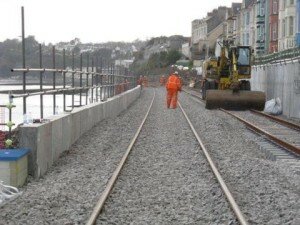In the next few days the main train line running along the sea wall at Dawlish will re-open. The image of the track swinging above a massive void with the sea smashing away below is perhaps the most iconic image of the winter storms of 2014.
It is hard to believe that the damage which occured on the 4th February and which was so extensive has now been repaired in only about eight weeks. At the time that Rail Track announced their target for early April most voices were sceptical as to their chances of having the line repaired in such a short amount of time. This was especially the case as subsequent storms compounded the damage done on that night. However, and just as with the Olympics of 2012, the critics have been confounded and British people have demonstrated just how remarkable and wonderful this country can be.
Despite the innevitable euphoria that will surround the re-opening of the line, questions will continue about the viability of maintaining such a vulnerable stretch of railway. The beauty of this piece of railway is also its Achilles heal for it runs along the base of cliffs and open sea for 4 miles and it should be remembered that this is the main and only line running into most parts of Devon and certainly all of Cornwall. In 2010 it was estimated that the annual maintenance costs were £500,000 for just keeping the sea wall and cliffs in safe repair. It could be argued that had they increased this figure the multi million pound costs of the current closure and repairs might not have been needed.
The line has always been subject to damage. In 1852 only a short while after it had been built the line was closed for 4 days due to a land slip near Teignmouth, further serious damage occured in 1855 and 1859. In the years since there have been periodic closures due to damage. This had led some to suggest that an inland route be built to avoid these problems. In the years immediately before World War II, a project was approved and started and the then GWR began construction. However, the start of war brought it to an end and in the post war world which was short of money, the nationalised British Rail abandoned the project completely and sold off the land that had been acquired.
Currently, the prospects of an alternative to the current route seems extremely unlikely especially given the current problems the Government is facing with HS2 and controlling the defecit.
For the people of The West Country the re-establishment of the rail link will be an occasion for great celebration. Interestingly enough about 92% of visistors to the region actually come by car but even so a break in the rail link for such a protracted period of time has hurt the South West economically.
Holiday resorts such as the English Riviera will breathe sigh of relief as the publicity surrounding the re-opening of the railway line will emphasise how the South West is open for business and ready to accept visitors. The numerous attractions and guest accommodation in towns like Torquay have suffered from people’s misconceptions about the extent of the damage done in the storms. The reality has been that even with the poor weather most tourism businesses have been able to continue offering short breaks for guests wanting to enjoy all Torquay, Paignton and Brixham have to offer. There are plenty of late deals on offer and accommodation ranging from the very cheapest budget hotels to luxury boutique hotels and from holiday camps to self-catering holiday apartments will have plenty of availability. Once the railway link focuses minds on the fact that the South West is truly open for business, then that availability might rapidly disappear.


